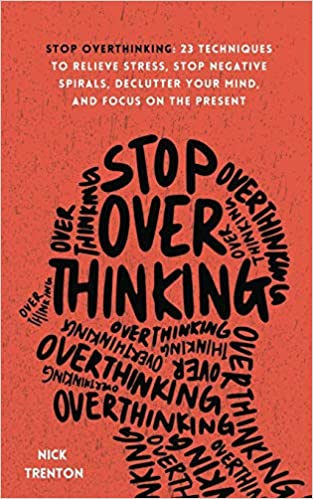Stop Overthinking — Book Summary
Introduction
This book is about the different ways of combating anxiety that leads to overthinking. The author takes us through the importance of reducing overthinking, how it's related to anxiety and different techniques to stop thinking so much.
Interesting quotes from the book
By planning ahead, you waste no time or willpower making decisions about what to do, and you can ensure you always begin with your priorities.
— Nick Trenton, Stop Overthinking
We don't see the filter we pass reality through, but in truth, we all view the world through our own personalized set of expectations, beliefs, values attitudes, biases, assumptions or flat-out illusions.
— Nick Trenton, Stop Overthinking
Summary of the book Stop Overthinking
Chapter one begins by telling us that overthinking is not all about overthinking. It explains that overthinking is when our thought process is out of control, putting our cognitive instinct in overdrive, that is overthinking.
It further explains that being analytic, evaluating, and worrying, ruminating are not terrible qualities. However, some of them become bad when they aid our overthinking. Overthinking comes with anxiety, and anxiety has two major causes: genetics and the environment. When we live in an environment full of unhealthy stress, we develop anxiety.
Chapter two begins by explaining how to combat overthinking caused by stress. The first is by using the 4 A's of stress management. They include:
- avoid (what you cannot control),
- alter (alter the stressors),
- accept (accept it),
- adapt (to cope with stressors).
Another method is by keeping a stress diary or journal. Writing our thoughts enables us to analyze them and notice some patterns which when worked on can help us reduce stress.
The last technique is the 5-4-3-2-1 technique used to deal with panic attacks, but can also avoid the spiraling of anxiety. When you feel panic creeping into you, look around your environment and focus on five things you can see. After that, focus on four things you can touch. Next, look out for three things you can smell. Also, focus on two things you can hear and finally one thing you can taste. Take another deep belly breath to end and follow the 5-5-5 rule. Breathe in for 5 seconds, hold it for next 5 seconds, and finally breathe out for 5 seconds. This technique helps to distract your brain from overthinking.
Chapter three begins by explaining how we can manage our time and input. It points out that one of the major causes of anxiety is poor management of time. This is because we give priorities to things that don't matter and things that make us miserable. This prevents us from relaxing when there is a need for it.
To manage our time properly, the chapter discussed some techniques to follow. They are: Allen's input processing method, where inputs are external stimuli. We need to learn how to take more and analyze these stimuli which are actually things that can take our time like emails, calls, etc.
After that, we make plans and prioritize the most important over the less important.
Another technique is by setting SMART goals. Smart here stands for (Specific, Measurable, Attainable, Relevant, and Time-bound).
Chapter four begins with explaining how to find instant Zen. Zen here refers to calmness. Anxiety can become unbearable and threaten to go out of control. The best way to deal with it is usually through reducing your stress level following some well-known techniques.
The first technique is antigenic training which helps you to gain control over your thighs and emotions following six different exercises.
The second technique is referred to as guided imagery. Here you are required to find a comfortable position, think of a place that engages your five senses in a pleasant and stimulating way. Make sure the place makes you feel relaxed. In position, with the help of your imagination, picture the awesomeness of the place as it begins to relax your nerves and.
The final technique is the progressive muscle. This technique is built on the tenets that physical relaxation can bring about mental relaxation. You achieve this by first of all tensing your muscles up. To tense your muscles up, find a comfortable position and sit. Move from head to toe or in reverse order. This will make the different parts of your body tense. After that, allow yourself to relax.
Chapter five begins with the need to rewire our thought pattern. Being stock in negative thought patterns causes lots of anxiety. But with use of Cognitive Behavioral Therapy, we can identify these thought patterns and replace them with positive thought patterns. Doing this will not only change your way of thinking, but it will also improve your mental health.
To do this, the first thing to do is
identify the different cognitive distortion you have allowed your mind to conjure. Some of these distortions can be a black-and-white pattern of thinking where you think of things in the extreme. In this state of mind, something is very good or terrible, not in between.
Another way of rewiring our brain is by becoming mindful of what we are focusing on. Focusing on bad thighs can lead you to distort your way of thinking and affect what your reality should be. You can attempt to always pull away from bad thoughts, people, surroundings, and situations when they creep into your brain. Realizing it helps to make it easy to pool away before it does you any harm.
Chapter six begins with looking at new found attitude and emotional regulation. This chapter discusses how we can use some techniques to keep our new good habits.
Some of those techniques in life focus on what you can control, what you can do, and what you have. These attitudes help you avoid unnecessary thinking of what you could have done if you had this, could do that or could control that. It helps to channel your mind within your range.
Also, this chapter encourages us to live in the present and not in the future. This is a good way of saying plan for the future but enjoy the present while you work toward the future. So do not abandon the present for the future which you don't know what it holds.
Key Lessons from the Book
Lesson 1: Avoid stress by managing your time and input.
To deal with stress, we have to become good at time management.
You can do this by:
- Identifying your priorities and use them a your good for your goals.
- Try Allen's input processing technique which says that a plan helps you avoid wasting precious time.
- Also, you can try Eisenhower's method of time management. It holds that to utilize your time you need to deal with what matters and let the rest be.
- Also, set SMART goals (specific, measurable, attainable, relevant, and time-bound).
Lesson 2: Rewire your thought pattern
The mind, body and emotions are connected, but in an anxiety situation, the mind takes the upper hand. Its actions influence the other two.
However, through Cognitive Behavioral Therapy (CBT), you can get rid of distorted thoughts. If you don't, when these thoughts become a pattern, it becomes difficult to break them and your mindset could affect your situation.
To work on your thought pattern, consider the following:
- Avoid overgeneralization. Watch what you internalize and avoid external factors from affecting your mindset.
- Avoid favoring negative thoughts over the positive ones. Do not reason with your emotions, rather with your logic.
Lesson 3: To avoid anxiety, reduce your stress level by doing some physical relaxation exercise.
Ways to do so include:
- Autogenic training (it helps you gain control over your thoughts and emotions through different levels of exercise)
- Guided imagery
- Progressive muscle relaxation (it helps your body relax by relaxing every-tensed and stressed muscles within you.)
You can also reduce stress by focusing on what you can control; most times we feel powerless towards situations that are not within our control. We stress ourselves by thinking of the possible way to handle the situation which leads us to lose control of our thoughts.
To avoid this situation, channel your focus on what you can control, what you have, what you can. It will help you avoid overthinking.
Review of the book Stop Overthinking
I'm just halfway through this book and I already feel like this is speaking to me! When it comes to overthinking, I recognize a lot of myself in this book, and it gets the point across well. It is a really encouraging and inspiring book that gives wonderful examples and strategies to avoid overthinking.
Conclusion
This was a fantastic book to read! The deconstruction of thinking and the many techniques to employ were really interesting to me. This is the sort of book you could find yourself returning to when you need to unwind. It was well-written.
Don't miss the other book summaries on SunInMe.org

